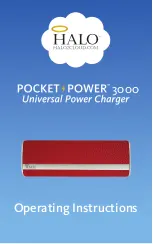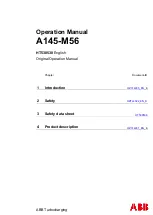
10
If the battery remains connected, in order to keep it charged,
compensation and subsequent equalisation charging
operations will be initiated automatically, depending on the
type of battery.
2. If an equalisation charging operation has been
programmed (unsealed lead/acid battery), this is
initiated automatically.
If this is not the case, equalisation charging can be
initiated manually: please refer to the section on
Completion of charging with equalisation.
3. If the green light is flashing, the battery is in its resting
phase.
Wait until the light stops flashing.
4. Set the Start/Stop switch to “0”.
5. Disconnect the battery, which is now ready for use.
Completion of charging with equalisation
Equalisation only concerns unsealed lead/acid batteries. It
can be initiated either manually or automatically.
Manual initiation
1. As soon as charging is complete (the green light is
permanently lit or is flashing - Fig.2, No. 7), press
the
button.
The messages
EQUAL I
= (equalisation current) and
EQUAL
H = (remaining equalisation time) (Nos. 1 and 2
below) indicate that equalisation has been initiated.
2. The battery is ready for use as soon as the green light
(Fig. 2, No. 7) illuminates.
Automatic initiation
If equalisation has been programmed (Configuration Menu /
Equal time, Delayed equal and Auto equal set to ON),
equalisation charging is initiated automatically.
Furthermore, if the battery remains connected, in order to
keep it charged, maintenance charges (compensation and
subsequent equalisation charging operations) will be initia-
ted automatically, depending on the type of battery. The
same information as for manual initiation is displayed (see
above).
Display of the history per charging operation
To display the memorised information and to reset it to
zero, please refer to the Memory section.
Display of the charger’s history
To display the history and to reset it to zero, please refer to
the Status section.
Fault messages
Fault
Cause
Remedial action
DC
Appears before a DF1
fault is displayed.
DF1*
Charger fault.
Check the power supply
voltage.
DF2*
Output fault.
Check that the battery is
correctly connected (that
the cables are not
reversed) and the output
fuse.
DF3*
Unsuitable battery.
Battery voltage too high
or too low. Connect the
correct charger for the
battery
DF4
The battery has been
Charging continues.
discharged more than
80% of its capacity.
DF5
Battery requires
Check the charging
inspection.
cables (cross-section too
small), the terminals
(oxidisation, not tight)
and the battery
(defective elements).
DF7
Pneumatic mixing air Check the air
circuit fault (the red
circuit (pump, tubing).
light flashes).
TH*
Thermal fault
Check that the fan(s)
resulting in
is (are) working
interruption of
correctly and/or
charging.
that the ambient
temperature is not too
high or whether there is
poor natural ventilation
to the charger.
STOP*
Critical electrolyte level in the battery.
Fill the battery.
(*): A blocking fault preventing charging from continuing.
Technical characteristics of Premium HF flex
Units
2004
2006
2008
2010
Power supply voltage
V
400 ±10% tri
400 ±10% tri
400 ±10% tri
400 ±10% tri
Frequency
Hz
50/60
50/60
50/60
50/60
Current absorbed
A
7
10
13
17
Power supply cable
mm
2
4 x 2.5
4 x 2.5
4 x 4
4 x 4
Power supply fuse
A
Protistor 20A
Protistor 20A
Protistor 30A
Protistor 30A
Battery cable (1)
mm
2
25
25
50
50
Battery cable length
m
1 to 10
1 to 10
1 to 10
1 to 10
IP protection level
IP20
IP20
IP20
IP20
Operating temp.
°C
0 to +40
0 to +40
0 to +40
0 to +40
Display
LCD
LCD
LCD
LCD
Weight
kg
30
30
30
55
Dimensions (H x W x D)
mm
750x410x317
750x410x317
750x410x317
940x410x317
(1) Take the electrical installation into account when determining the actual cable cross-section.




























